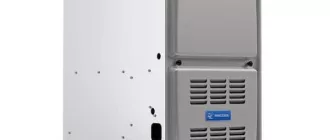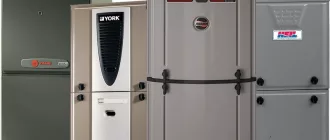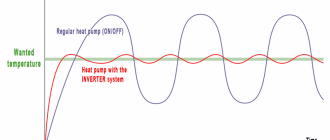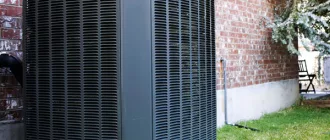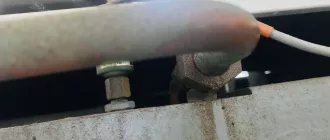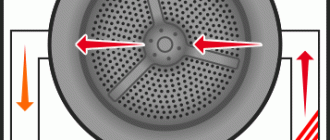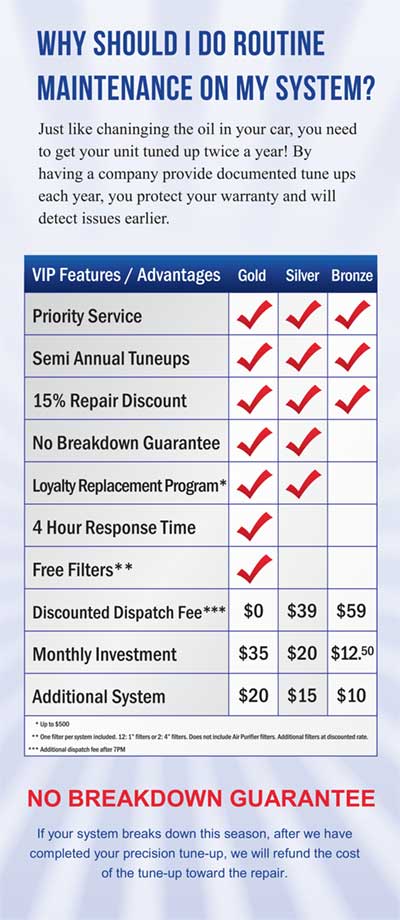
Get Ready for Spring and Summer with This Essential Air Conditioning Checklist
As we enter the spring season, it’s time to start thinking about the hot summer days that are just around the corner. One of the most important things you can do now to ensure your comfort during the summer months is to prepare your air conditioning system. By following a simple checklist, you can make sure that your air conditioner is in optimal condition and ready to keep you cool when the temperatures rise.
First and foremost, it’s essential to schedule a professional maintenance check for your air conditioning unit. A trained technician will inspect and clean all the components of your system, including the filters, coils, and condensate drain. They will also check for any potential issues that could cause your unit to malfunction or operate less efficiently. Regular maintenance can help prolong the lifespan of your air conditioner and prevent costly repairs.
Another important step in preparing your air conditioning system for the summer is to clean or replace the air filters. Dirty filters can restrict airflow and make your unit work harder to cool your home, leading to higher energy bills. By cleaning or replacing the filters, you can ensure that your air conditioner operates efficiently and provides clean, healthy air.
Don’t forget to check the thermostat settings. Resetting the temperature and programming your thermostat correctly can help you save energy and money during the summer months. Consider setting a schedule that reduces the cooling when you’re not at home or during the night when temperatures are typically lower.
By taking the time to prepare your air conditioning system now, you can enjoy a comfortable and energy-efficient summer. Following this checklist will not only help you save money on your energy bills but also provide peace of mind knowing that your air conditioner is ready to handle the hot temperatures ahead.
Spring Air Conditioning Checklist
As spring approaches, it’s time to start thinking about your air conditioning system and preparing for the summer heat. Follow this checklist to ensure that your conditioning is in top shape:
- Schedule a professional maintenance service for your air conditioning unit. This will help identify any potential issues and ensure that it is working efficiently.
- Clean or replace the air filters. Dirty filters can restrict airflow and reduce the efficiency of your system.
- Check and clean the outdoor condenser unit. Remove any debris or obstructions that could hinder airflow.
- Inspect the ductwork for any leaks or damage. Seal any gaps or cracks to prevent leaks and improve efficiency.
- Adjust the thermostat settings for the upcoming warmer weather. Consider investing in a programmable thermostat for more precise control.
- Test the air conditioning system to make sure it is cooling properly. If you notice any issues, schedule repairs as soon as possible.
- Consider installing a ceiling fan or using portable fans to help circulate cool air and reduce the workload on your air conditioner.
- Ensure that your home is properly insulated to keep cool air in and hot air out. Check for any gaps or insulation issues.
- Keep the area around the outdoor unit clear of vegetation and debris. This will help maintain good airflow and prevent damage.
- Consider investing in a maintenance plan to keep your air conditioning system in top shape all season long.
By following this checklist, you can ensure that your air conditioning system is ready for the upcoming spring and summer months. Don’t wait until it gets hot – prepare now to stay cool and comfortable.
Start Early: Prepare for Spring and Summer
As spring approaches and the hot summer days are just around the corner, now is the perfect time to start preparing your air conditioning system. By following a checklist, you can ensure that your unit is in top condition and ready to keep you cool when the temperatures rise.
| 1 | Check Filters: | Inspect and clean or replace the air filters in your conditioning system. Dirty filters can restrict airflow and decrease the efficiency of your unit. |
| 2 | Clean Vents and Ducts: | Remove any debris or dust from the vents and ducts to ensure proper airflow throughout your home. This will help your conditioning system cool your house more efficiently. |
| 3 | Inspect Outdoor Unit: | Take a look at the outdoor unit of your air conditioning system. Clear away any vegetation or debris that may have accumulated around it. Also, check for any signs of damage or wear. |
| 4 | Schedule Maintenance: | Contact a professional HVAC technician to perform a thorough maintenance check on your conditioning system. They can identify any potential issues and make necessary repairs before the summer heat arrives. |
| 5 | Upgrade Thermostat: | Consider upgrading to a programmable thermostat that allows you to set different temperatures for different times of the day. This can help you save energy and money throughout the spring and summer. |
By starting early and following this checklist, you can ensure that your air conditioning system is in optimal condition and ready to provide you with cool and comfortable indoor temperatures during the spring and summer seasons.
Clean and Check the Air Filters
As the summer approaches, it’s important to include cleaning and checking the air filters in your spring checklist now. Air filters play a vital role in keeping your air conditioning system running efficiently and maintaining good air quality in your home.
Over time, air filters can become clogged with dirt, dust, and other particles, which can restrict airflow and lead to decreased cooling efficiency. This can result in higher energy bills and a less comfortable indoor environment. By cleaning and checking the air filters now, you can prevent these issues from occurring during the hot summer months.
To clean the air filters, simply remove them from the air conditioning unit and gently rinse them with water. Allow the filters to dry completely before reinstalling them. It’s also important to check the condition of the filters and replace them if they are damaged or excessively dirty.
Regularly cleaning and checking the air filters not only helps to improve the performance of your air conditioning system but also enhances the overall air quality in your home. This is especially important for individuals with allergies or respiratory conditions.
So, don’t wait until summer arrives to clean and check your air filters. Add it to your spring checklist now and enjoy a comfortable and healthy indoor environment all summer long.
Schedule a Professional Maintenance Visit
As spring turns into summer, it’s important to ensure that your air conditioning system is running efficiently and effectively. One way to do this is by scheduling a professional maintenance visit for your HVAC system. This step is crucial in preparing your air conditioning for the upcoming months.
A professional maintenance visit typically includes an inspection of your air conditioning unit, cleaning of coils and filters, and checking for any potential issues or repairs that may be needed. By taking care of these tasks now, you can prevent any major problems from occurring during the hotter months.
During the visit, the technician will also check the refrigerant levels and ensure that your system is properly charged. They will inspect the electrical connections, lubricate moving parts, and tighten any loose components. These steps will not only improve the performance of your air conditioning but also extend the lifespan of your system.
Regular maintenance visits can also help to improve the air quality in your home. Dust and debris can accumulate in your air conditioning system, leading to poor indoor air quality. A professional technician will clean the coils and filters, removing any build-up and ensuring that the air circulating in your home is clean and fresh.
By scheduling a professional maintenance visit for your air conditioning system now, you can ensure that your home is cool and comfortable during the hot summer months. Don’t wait until the first heatwave hits to discover that your air conditioning is not working properly. Take action now and add this important task to your spring checklist.
Inspect the Exterior Unit
As part of your spring air conditioning checklist, it is important to inspect the exterior unit. The exterior unit plays a vital role in the function of your air conditioning system, especially during the hot summer months.
Start by ensuring that the unit is clear of any debris, such as leaves, twigs, or dirt. This debris can block the air flow and reduce the efficiency of your conditioning system. Use a broom or brush to gently remove any debris from the unit.
Next, visually inspect the unit for any signs of damage or wear. Look for cracks in the housing, loose or damaged wires, or bent fins on the fan. If you notice any issues, it is important to address them promptly to prevent further damage.
Additionally, check the area around the unit for any obstructions. Trim back any bushes, plants, or shrubs that may be too close to the unit. This will ensure proper air flow and prevent potential damage to the system.
Finally, consider scheduling a professional maintenance service for your air conditioning system. A professional technician can thoroughly inspect and clean the unit, as well as perform any necessary repairs or tune-ups. This will help ensure that your system is in optimal condition for the upcoming summer season.
By inspecting the exterior unit as part of your spring air conditioning checklist, you can prepare your system for the summer months and ensure that it runs efficiently and effectively.
Clean the Condenser Coils
As summer approaches, it’s important to add cleaning the condenser coils to your air conditioning checklist. Now is the perfect time to prepare your AC unit for the hot months ahead.
The condenser coils are an essential component of your air conditioning system. They are responsible for transferring heat from inside your home to the outside. However, over time, these coils can become dirty and clogged, reducing their effectiveness and efficiency.
To clean the condenser coils, start by turning off the power to your AC unit. Then, use a soft brush or cloth to gently remove any debris, dirt, or grass clippings that may have accumulated on the coils. Be careful not to damage the delicate fins on the coils.
After removing the surface dirt, you can use a coil cleaner or a mixture of mild detergent and warm water to thoroughly clean the coils. Apply the cleaner according to the manufacturer’s instructions and let it sit for a few minutes to dissolve any stubborn dirt or grime. Then, rinse the coils with clean water to remove the cleaner and dirt.
Regularly cleaning the condenser coils of your air conditioning system can help improve its efficiency, reduce energy consumption, and extend its lifespan. So, don’t forget to add this important task to your spring air conditioning checklist!
Clear the Surrounding Area of Debris
As you prepare your air conditioning system for spring and summer, it’s important to take some time to clear the surrounding area of debris. Over the winter months, leaves, twigs, and other debris can accumulate around your outdoor unit, hindering its performance.
Start by removing any large branches or debris that may be touching or blocking the unit. Use a broom or leaf blower to sweep away any smaller debris, such as leaves or dirt, that may have collected around the unit.
Additionally, trim any nearby bushes or shrubs that may be obstructing the airflow to the unit. Good airflow is essential for your air conditioning system to function properly and efficiently.
Clearing the surrounding area of debris not only improves the performance of your air conditioning system but also reduces the risk of damage to the unit. Debris can obstruct the airflow, causing the system to work harder and potentially leading to overheating or breakdowns.
- Remove large debris such as branches or fallen leaves
- Use a broom or leaf blower to clear small debris
- Trim bushes or shrubs obstructing the airflow
- Ensure good airflow for optimal system performance and efficiency
By taking the time to clear the surrounding area of debris, you can ensure that your air conditioning system is ready to keep you cool and comfortable throughout the spring and summer months.
Check the Condensate Drain Line
As spring and summer approach, it’s important to prepare your air conditioning system for the warmer weather. One important item to add to your checklist is checking the condensate drain line.
The condensate drain line is responsible for removing moisture from your air conditioner. Over time, this drain line can become clogged with dirt, debris, or algae, preventing it from functioning properly. A clogged drain line can lead to water leaks, reduced cooling efficiency, and even potential water damage to your home.
To prevent these issues, it’s essential to check and clean the condensate drain line. Start by locating the drain line, which is typically located near the indoor unit of your air conditioner. Next, inspect the line for any signs of blockage, such as standing water or visible debris. If you notice any blockages, use a wet/dry vacuum or a small brush to remove the dirt or debris.
In addition to cleaning the drain line, it’s also important to ensure that it is properly sloped. A properly sloped drain line allows for efficient water drainage. Use a level to check the slope of the drain line and adjust it if necessary.
Regularly checking and cleaning the condensate drain line will help prevent issues and keep your air conditioner running smoothly throughout the spring and summer months. By including this task in your spring air conditioning checklist, you can ensure that your system is ready to keep your home cool and comfortable.
Test and Calibrate the Thermostat
One important step to take to prepare your air conditioning for the spring and summer is to test and calibrate the thermostat. The thermostat is what controls the temperature in your home, so ensuring it is working properly is essential for efficient cooling.
Start by testing the thermostat to make sure it is responding correctly. The easiest way to do this is to set the thermostat to a temperature lower than the current room temperature and see if the air conditioning turns on. If it doesn’t, there may be an issue with the thermostat that needs to be addressed.
If the thermostat is functioning properly, you should then calibrate it to ensure accurate temperature readings. Over time, thermostats can become less accurate, leading to inefficient cooling and higher energy bills. To calibrate the thermostat, you will need a separate thermometer to compare the temperature readings.
Place the thermometer next to the thermostat and wait for a few minutes to allow them to reach the same temperature. Then, check the temperature reading on both the thermometer and the thermostat. If there is a significant difference, you will need to adjust the calibration settings on the thermostat.
Refer to the manufacturer’s instructions or consult a professional if you are unsure of how to calibrate your particular thermostat model. Making sure your thermostat is accurately calibrated will help optimize your air conditioning system and keep your home comfortable during the spring and summer months.
Inspect and Lubricate Motors and Bearings
As a part of your spring air conditioning checklist, it’s important to inspect and lubricate the motors and bearings of your HVAC system. By taking care of this now, you can ensure that your system will run smoothly and efficiently throughout the summer months.
Start by visually inspecting the motors and bearings for any signs of wear or damage. Look for frayed wires, loose connections, or excessive dirt and debris. If you notice any issues, it’s important to address them promptly to prevent further damage.
Next, lubricate the motors and bearings to keep them running smoothly. Use a high-quality lubricant recommended by the manufacturer of your HVAC system. Be sure to follow the manufacturer’s instructions for proper lubrication technique and amount of lubricant to use.
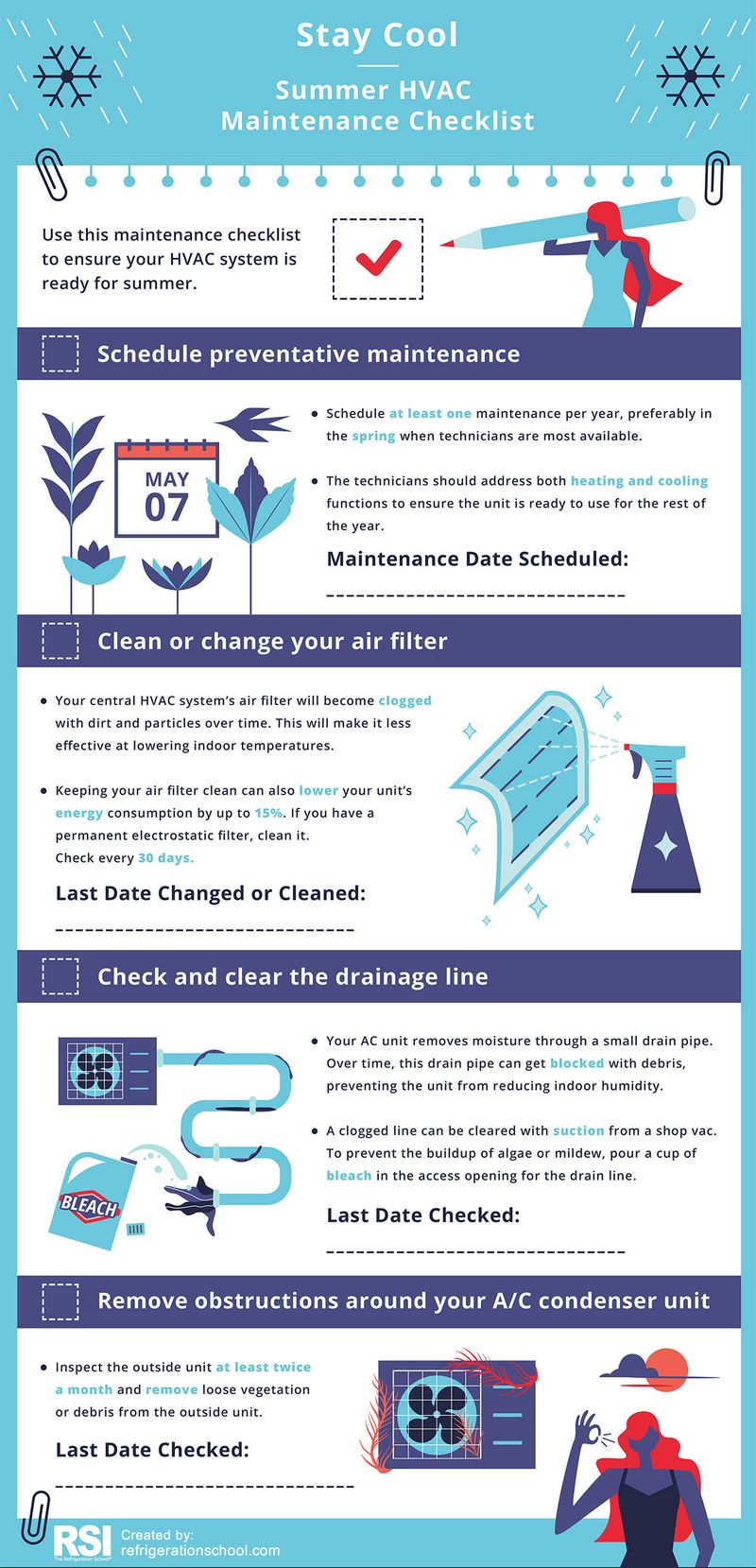
Regularly inspecting and lubricating the motors and bearings of your air conditioning system can help prevent breakdowns and extend the lifespan of your system. It’s a simple step that can make a big difference in the overall performance and efficiency of your HVAC system.
If you’re not confident in your ability to inspect and lubricate the motors and bearings yourself, it’s always best to hire a professional to do the job. They have the knowledge and experience to ensure that the job is done correctly and safely.
| Inspect and Lubricate Motors and Bearings | This step is crucial to ensure the smooth and efficient operation of your HVAC system. |
| Clean and Replace Air Filters | Dirty air filters can restrict airflow and decrease the efficiency of your system. |
| Check and Adjust Thermostat Settings | Make sure your thermostat is set to the appropriate temperature for the season. |
| Clean and Clear the Outdoor Unit | Remove any dirt, leaves, and debris that may be blocking the outdoor unit. |
Check and Adjust the Blower Belt
As part of your spring air conditioning checklist, it is important to check and adjust the blower belt. The blower belt is responsible for powering the blower fan, which circulates the cooled air throughout your home. Over time, the blower belt can become loose or worn, leading to decreased efficiency and performance.
To check the blower belt, first, turn off the power to your air conditioning unit. Locate the blower compartment, which is typically located near the air handler. Remove any access panels or covers to expose the blower assembly.
Inspect the blower belt for any signs of wear or damage. Look for cracks, fraying, or stretching. If you notice any of these issues, it is important to replace the belt as soon as possible. A loose or worn blower belt can cause the blower fan to work harder, increasing energy consumption and potentially leading to premature failure.
If the blower belt appears to be in good condition, check the tension. A properly tensioned blower belt should have around ½ inch of give when pressed down in the middle. Use a wrench or socket to adjust the tension if necessary. Be careful not to overtighten the belt, as this can cause damage.
Once you have checked and adjusted the blower belt, replace any access panels or covers and restore power to your air conditioning unit. Turn on your system and listen for any unusual noises or vibrations. If you notice anything out of the ordinary, contact a professional technician for further inspection and repairs.
By checking and adjusting the blower belt now, you can ensure that your air conditioning system is operating at maximum efficiency and performance. This will help keep your home cool and comfortable during the hot spring and summer months.
Inspect and Clean the Evaporator Coils
As you prepare your air conditioning system for the coming spring and summer seasons, it’s important to include a thorough inspection and cleaning of the evaporator coils on your checklist. The evaporator coils play a crucial role in the cooling process, as they absorb the heat from the air inside your home.
Over time, these coils can become dirty and clogged with dust, dirt, and other debris. This can lead to reduced efficiency and performance of your air conditioner, as well as potential damage to the system. Therefore, it’s essential to inspect and clean the evaporator coils to ensure optimal functioning.
You can start by visually inspecting the coils for any signs of dirt or debris buildup. If you notice any accumulation, it’s time to clean them. To clean the evaporator coils, you’ll need to turn off the power to the air conditioner before accessing them. You can use a soft brush or a vacuum cleaner with a brush attachment to carefully remove the dirt and dust.
It’s important to be gentle while cleaning the coils to avoid causing any damage. You should also take care not to bend or distort the delicate fins on the coils. If you’re unsure about how to clean the evaporator coils properly, it’s recommended to consult a professional HVAC technician for assistance.
Regularly inspecting and cleaning the evaporator coils will not only help improve the efficiency of your air conditioning system, but it will also contribute to better indoor air quality. By ensuring that the coils are clean and free from debris, you can enjoy a cool and comfortable home throughout the spring and summer seasons.
In conclusion, don’t forget to include the inspection and cleaning of the evaporator coils on your spring air conditioning checklist. Take the necessary steps now to prepare your air conditioning system for the upcoming seasons, and you’ll be able to enjoy reliable and efficient cooling when you need it most.
Test the Start and Run Capacitors
As part of your spring air conditioning checklist, it’s important to test the start and run capacitors. These devices are responsible for providing the necessary electrical charge to start and keep the condenser motor running smoothly.
Start capacitors provide the initial boost of power to start the motor, while run capacitors provide a continuous supply of electricity to keep the motor running efficiently. Over time, these capacitors can become weak or fail completely, resulting in problems with motor starting and performance.
To test the start and run capacitors, use a multimeter set to the capacitance function. Start by disconnecting the power to the air conditioning unit and locating the capacitors. Carefully discharge any stored electrical charge by using an insulated screwdriver to short the terminals together. Then, remove the capacitors from their mounting brackets.
Using the multimeter, touch the probes to the terminals on the capacitors. The reading should be within the range specified on the capacitor’s label. If the reading is significantly higher or lower than the recommended range, the capacitor may be faulty and should be replaced.
Testing the start and run capacitors is an important step in preparing your air conditioning system for spring and summer. By ensuring these devices are in good working order, you can prevent potential breakdowns and ensure your system operates efficiently throughout the hot months.
Remember to always exercise caution when working with electrical components. If you’re unsure about performing this test yourself, it’s best to contact a professional HVAC technician to inspect and service your air conditioning system.
Inspect and Tighten Electrical Connections
As part of your spring air conditioning checklist, it’s important to inspect and tighten electrical connections to ensure that your system is running smoothly and efficiently. Over time, the vibrations and regular use can cause electrical connections to become loose or worn out.
Loose electrical connections can lead to electrical arcing, which can be a fire hazard and cause damage to your air conditioning unit. By inspecting and tightening these connections now, you can prevent any potential issues from occurring during the summer when your air conditioning system is working hard to keep you cool.
Here are a few steps you can take to inspect and tighten electrical connections:
- Turn off the power: Before you begin working on any electrical connections, make sure to turn off the power to your air conditioning unit. This can usually be done by switching off the circuit breaker or disconnecting the power supply.
- Remove the access panel: Locate the access panel on your air conditioning unit and remove it. This will give you access to the electrical connections and components.
- Inspect the connections: Carefully inspect each electrical connection for signs of wear or damage. Look for loose or corroded wires, as well as any signs of burning or melting. If you notice any issues, it’s important to address them immediately.
- Tighten the connections: Using a screwdriver, wrench, or pliers, gently tighten any loose connections. Be careful not to overtighten, as this can cause damage. If you’re unsure, it’s best to consult a professional.
- Test the system: After tightening all the electrical connections, replace the access panel and restore power to your air conditioning unit. Test the system to ensure that everything is working properly.
By taking the time to inspect and tighten electrical connections now, you can ensure that your air conditioning system is ready to keep you cool all summer long. Remember to always prioritize safety and consult a professional if you’re unsure about any steps of the process.
Check Refrigerant Levels and Insulate Refrigerant Lines
As spring approaches, it’s important to prepare your air conditioning system for the upcoming summer months. One crucial step in this process is to check the refrigerant levels and insulate the refrigerant lines.
Refrigerant is the substance responsible for cooling the air in your AC unit. Over time, refrigerant levels can drop, which can greatly affect the performance and efficiency of your system. Therefore, it is essential to ensure that the refrigerant levels are at the manufacturer’s recommended level.
To check the refrigerant levels, you may need to contact a professional HVAC technician who has the proper tools and knowledge to do so. They will be able to measure the refrigerant levels and add more if necessary.
In addition to checking the refrigerant levels, it is important to insulate the refrigerant lines. The refrigerant lines are responsible for carrying the refrigerant between the indoor and outdoor units. If these lines are not properly insulated, they can lose energy, which can result in reduced cooling efficiency.
Insulating the refrigerant lines can be a simple and cost-effective solution. You can use foam insulation sleeves or wraps to cover the lines and prevent any energy loss. Insulating the lines will not only improve the efficiency of your air conditioning system but also help reduce your energy bills.
By checking the refrigerant levels and insulating the refrigerant lines, you are ensuring that your air conditioning system is in optimal condition for the upcoming spring and summer months. This simple step can help improve the performance and efficiency of your AC unit, resulting in a more comfortable indoor environment.
| Check Refrigerant Levels and Insulate Refrigerant Lines |
| Change Air Filters |
| Clean the Outdoor Unit |
| Inspect and Clean the Evaporator Coil |
| Check and Clean Condensate Drain |
Q&A:
What are some things I need to check before turning on my air conditioning unit in the spring?
Before turning on your air conditioning unit in the spring, it is important to check a few things. First, clean or replace the air filters to ensure proper airflow. Next, inspect and clean the outdoor condenser unit to remove any debris or dirt that may have accumulated during the winter. Finally, check the thermostat settings and make sure they are set correctly for the upcoming season.
Why is it necessary to clean or replace the air filters before starting the air conditioning unit in the spring?
Cleaning or replacing the air filters before starting the air conditioning unit in the spring is necessary to ensure proper airflow. Over time, dust, dirt, and other particles can accumulate in the air filters, restricting the flow of air through the system. This can lead to decreased efficiency and poor indoor air quality. By cleaning or replacing the filters, you can improve the performance of your air conditioning unit and maintain good indoor air quality.
How often should I clean or replace the air filters in my air conditioning unit?
The frequency with which you should clean or replace the air filters in your air conditioning unit depends on several factors, including the type of filters you have and the level of usage. As a general rule of thumb, it is recommended to clean or replace the filters every 1-3 months. However, if you have pets, live in a dusty environment, or use your air conditioning unit frequently, you may need to clean or replace the filters more often.
What are the benefits of inspecting and cleaning the outdoor condenser unit before the spring?
Inspecting and cleaning the outdoor condenser unit before the spring offers several benefits. First, removing any debris or dirt that may have accumulated during the winter helps to prevent airflow restrictions and potential damage to the unit. This can improve the efficiency and performance of your air conditioning system. Additionally, cleaning the condenser unit can help to prevent issues with overheating and prolong its lifespan. Overall, regular maintenance of the outdoor condenser unit is important for the proper functioning of your air conditioning system.

